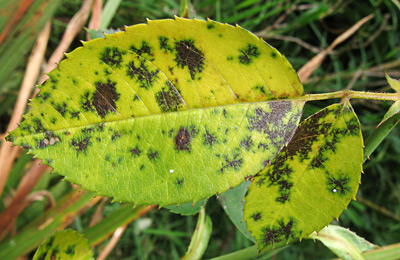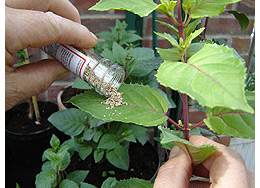Black Spot - Bacterial Disease
 Signs
- Purplish-black usually rounded blotches appear on leaves,
which then start to yellow and fall early leaving the plant
looking rather threadbare, flowering is reduced. Stems may be affected
in severe cases.
Signs
- Purplish-black usually rounded blotches appear on leaves,
which then start to yellow and fall early leaving the plant
looking rather threadbare, flowering is reduced. Stems may be affected
in severe cases.Damage - Badly affected plants may die as they are so seriously weakened they cannot withstand the winter frosts. It is very unsightly.
Treatment - A bacterial disease so one of the best ways of dealing with it is by good hygiene. This is particularly true for black spot as it over winters on fallen leaves and stem lesions. Remove all dead leaves in autumn to prevent the spores from over wintering, burn the leaves or take them to the skip rather than use them for garden compost or you may well just perpetuate the problem.
Prune out any damaged branches in the spring.
Black spot particularly attacks roses and it is important to keep them as healthy as possible so they can withstand attacks. Mulch with a good thick layer of well rotted farmyard manure or garden compost around the base of the plants in the autumn and spring. It is also worth searching out roses that show resistance to black spot.
Convalescence care - Plant diseases are often difficult to address directly, but you can help your plants get through an illness with some pampering and attention:
1 - Clear the base of any other plants, loosen any tight ties and add mulch. Make a circle of bare soil around the base of the trunk to at least a radius of 30cm (1ft), cover this with a thick layer of mulch, though don't pile it up against the trunk so it can "breathe".
2 - Give the plant a one-off generous feed, a full watering cans worth, 10L or 2 gallons of suitably diluted liquid feed.
3 - Water regularly if there's no rain, a full watering cans worth once a week if it doesn't rain or if there's only a sprinkle. NOT if the soil is already damp though.
4 - Trim other nearby plants, it may be that your plant is struggling in the shadow of other larger plants and isn't getting enough light to build its strength, which plant do you want the most?
![]() Elder spray. This kills
aphids, small caterpillars and is useful as a fungicide for
mildew and blackspot on roses. The toxic agent is hydro-cyanic
acid, so in preparing the spray use an old saucepan.
Elder spray. This kills
aphids, small caterpillars and is useful as a fungicide for
mildew and blackspot on roses. The toxic agent is hydro-cyanic
acid, so in preparing the spray use an old saucepan.
Gather 450g (1 lb) leaves and young stems of elder preferably
in spring when the sap is rising. Place in the saucepan and
add 3.3 litres (6pt) water. Boil for half an hour, topping up
as necessary. Strain through old tights and use the liquid cold
and undiluted. It will keep for three months if bottled tightly
while still hot.
Case study
Q. We have a strawberry tree (arbutus unedo) which we planted about 7 years ago. The tree has grown to about 18 feet, with abundant healthy foliage on the new growth. However, the leaves seem to rapidly develop black spots and die back, leaving only the most recent growth healthy and intact. Any regrowth that occurs along the stem also seems to rapidly suffer the same fate.
The supplier of the plant says that only the outermost layer of leaves will remain in a normal specimen, but I think that the tree is not entirely healthy, as indicated by the blackening of the leaves. Any ideas what we can do?
The tree is in a sunny position, on slightly acid, clay soils. The site is not waterlogged, as the tree is at the top of a bank, adjacent to a pond.
A. I'd agree with you. Strawberry trees are susceptible to leaf spot diseases and it sounds quite clearly that some infectious agent is responsible for what is happening. I know of no case where plants lose leaves in the manner that you describe by any normal means of dropping mature leaves.
I'd guess that the cause is bacterial similar to what happens to roses with "black spot". The cure is not easy to administer and the disease is quite resilient. The bacteria are usually spread by water-borne rain-splash or insects. Not watering will help if this is a contributory cause and it is not dry.
Remove all affected leaves and spray with Bordeaux mixture, remove fallen diseased leaves from beneath the tree and dispose of by burning or other means, but NOT on the garden compost heap. You may need to repeat this treatment several times to eradiate the disease.
The other alternative is that the spots are fungal in origin, in this case the spots appear to be concentric circles, close inspection may show pin-prick sized fruiting bodies. The treatment is the same but spray with benomyl or a copper-based fungicide.
Feedback - I didn't have enough Bordeaux mixture to treat the tree when I looked in the shed, so I used a modern systemic treatment that targets black spot. I used it at a fairly high concentrations & drenched the entire tree, including all the lower branches that had no leaves.. Within three or four days a large number of 'budlets' have formed, even in those areas which looked dead. So, I am going to repeat the treatment every two weeks, which is the maximum rate that they recommend, although I might reduce the concentration from now on.
I had almost given up hope, it looks like there may be a chance, yet ( our gardener was full of doom about the prognosis! ). Thanks for the help.... will keep you informed on progress.
Feedback 2 - I thought that I would give you an update on our Strawberry Tree. Evidently, it is an Andrachnoides, not Unedo, as I told you (or so our gardener tells me). Well, it was on the point of expiring, when I contacted you. You suggested spraying with Bordeaux mixture, but I didn't have enough - so I used Systhane from the Bio company. I have sprayed at quite a high concentration, every three weeks. The results have been really excellent. It seems to have stopped the fungus, are whatever, in its tracks & the tree is shooting new, undamaged, leaves throughout the branches. It really has been rescued 'in the nick of time'. Thanks to your help, and a bit of serendipity, it looks like it will be restored to full health...

Insect
hotel / house
A sheltered insect house to help a range of beneficial
insects to over-winter in your garden. If they are over-wintering there,
they are in an ideal position come the spring and summer to wake up and
help to combat any pests you may have. Amongst others, good for ladybirds,
lacewings and solitary wasps which will help keep your unwanted garden visitors
down. Place in a sheltered place outdoors.

Biological
Pest Control - Organic living pest control for a variety of
problems, red spider mite, whitefly, fungus gnats (sciarid fly), thrips, mealy bug,
vine weevils and more.
These are parasites or predators that will specifically infect the pest they are brought in to control without harming any other living things and without the use of chemicals. A small population of pests needs to be maintained so that the control agent doesn't die out.

Chemical insecticides - If your plants get a heavy infestation, then I think it's acceptable to use a chemical insecticide as a "smart missile" just on that particular plant. I resort to this when the aphids build up under cover on my favourite plum tree, or other plant/s. Don't overdo it and spray too often and don't spray the whole garden "just-in-case", buy a small 1L or thereabouts sprayer so you don't get carried away.
Not pest specific.
Copyright 2000 - present. All Rights Reserved | Privacy Policy Statement
